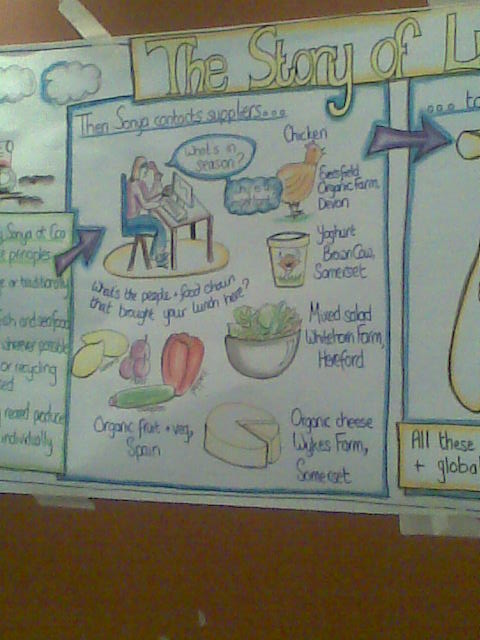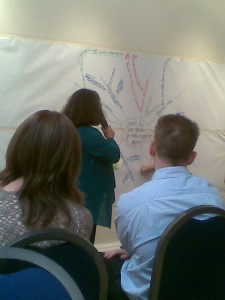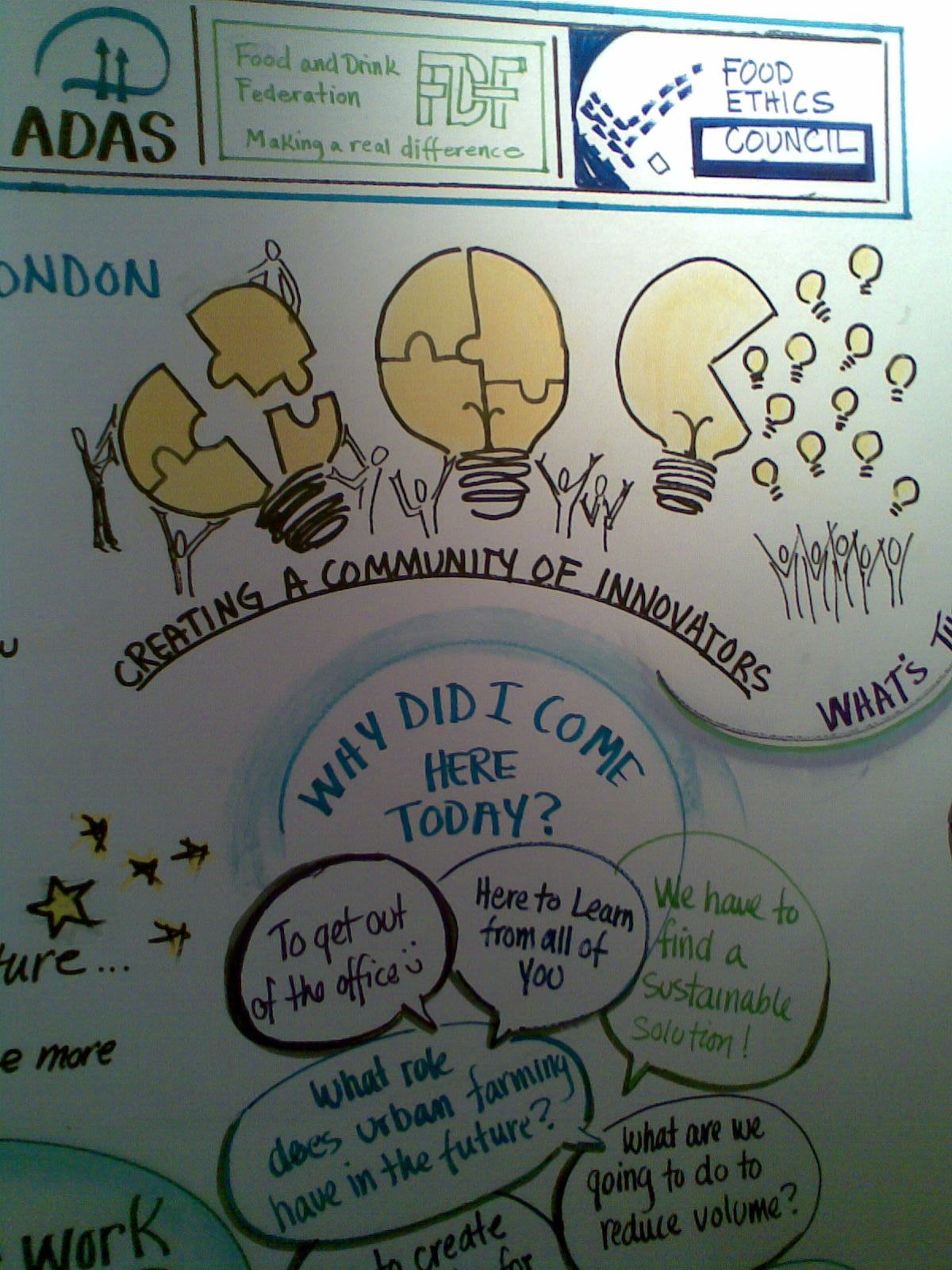The loo with an integrated handbasin which drains into the cistern; the fifty-page guide to recycling and rubbish disposal; the tiny boxes you can put your leftover food into at a café; the handbag size hand towel you take with you to use in public loos… I saw a lot of things in Japan which we could usefully adopt in the UK.
(Dis)engaging staff
"Who do they think they are preaching to?"
A visit to a client's canteen earlier this week brought me face-to-face with one extremely disgruntled staff member. In the queue, my contact pointed out the points-based reward system staff can now choose to join, which incentivises choosing a meat-free or meat-and-dairy-free meal. Like a coffee-shop loyalty card, you accumulate points and get mystery prizes. The explicit motivation is calorie-reduction and carbon-reduction: a vegan meal has, it is explained, a lower carbon footprint and is better for you.
Bottled up discontent
I asked whether there had been any controversy about the scheme, knowing that promoting a lower-impact or reduced-meat diet is considered very hard in this Defra research. Behind us, a member of staff neither of us knew spat out
"Well you're not allowed to disagree around here!"
She continued:
"Who do they think they're preaching to? What makes them think they're always right? What do they think they're doing interfering with our private lives?"
She was clearly very angry about it.
The organisation in question is one which has a public and explicit commitment to a low-carbon future, and it could be expected that a high proportion of staff are personally committed to reducing their environmental impact. So this reaction was surprising.
Unpacking the outburst
I think it's worth unpacking the points, to see if there's something to be learnt about engaging staff in this kind of impact-reduction activity:
- 'Preaching' is a word often used when the recipient of the message considers themselves to be at least as 'ethical', if not more, than the person transmitting the message. Perhaps this staff member considers herself to already have a strong personal set of ethics and practices, and resents the perceived implication that she needs to be told to do more. Perhaps she is unhappy about the way the organisation approaches its corporate impacts, and resents being asked to make a personal change when she thinks not enough is happening at the bigger level.
- 'What makes them think they are always right?' I wonder if there was an opportunity for knowledgeable people within the organisation to challenge the underlying generalisation that meat-free is healthier or better from a carbon perspective, or to contribute to developing the project. Perhaps this person has specialist knowledge which leads her to be uncomfortable with this simplification?
- 'Interfering with private lives'. This is an interesting one. The setting for this initiative is a staff canteen, possibly (I don't know) subsidised by the employer. People are not obliged to eat there, although it is cheaper and more convenient than going to local cafes. The scheme is voluntary, and around 1/3 of the staff have joined it. the scheme includes small incentives for 'better' choices, but there are no disincentives for 'poor' choices. Previous initiatives include asking people to use the stairs rather than the lift, and switching off equipment when not in use. These have been successful in reducing energy use in the buildings. What is it about eating, which makes it feel part of this person's 'private life'?
- 'You can't disagree around here'. This is a big problem in any organisation. When disagreement is counter-cultural to the point where a member of staff blurts it out to a stranger... There's something unhealthy about a level of top-down orthodoxy which means that it does not feel safe to say no. Every organisation needs mechanisms and culture which enable authentic conversation (this does not mean that every decision needs to be unanimous).
One dissenter?
Perhaps it doesn't matter that this one person feels this way. After all, staff take-up of the initiative seems pretty high, and the person I was meeting was an enthusiastic user of the points scheme.
Or this one person could be giving voice to concerns and needs which are shared more widely. If it's really the case that people find it very hard to tell colleagues that they disagree, then it will be hard to know.
Engage with resistance
Peggy Holman maintains that we serve our goals best when we engage with those who disagree and dissent. Seek out difference, listen harder, enquire into the needs and concerns which are being offered as a gift into the conversation, understand the common aims and see where a 'yes, and' response might lead.
Richard Seel similarly champions diversity as a critical condition for emergence of new ways of doing things.
Let's reflect together
What else might have been going on here? What could the scheme designers have done to avoid this? And what can they do now, to respond?
Let me know what you think...
Tasting the Future – tangy fresh process
As you may have noticed, I'm a process aficionado. I love to hear about innovative ways of helping people have the conversations they need. I love to try out new processes as a facilitator and a participant. I network with fellow facilitators through AMED, the IAF and a facilitators' group on linked-in. I read about unorthodox approaches, and sometimes I even try them with paying clients.
On Monday, I had the great treat of being a participant in someone else's workshop. There I saw for real - not in a training setting - open space, world cafe, graphic facilitation and live plenary mind mapping all used during the same meeting.
The event was the first 'assembly' for Tasting the Future, a collaborative whole-systems attempt to innovate the food system. It was organised by WWF, ADAS, the Food and Drink Federation and Food Ethics Council. Facilitation was provided by Hara Practice and Natural Innovation and other members of the hosting team. There were also some people doing graphic recording, from Intuitive Intelligence Training.
Some exciting conversations and actions emerged, and you can read more about them on the Tasting the Future ning. I'm going share some of the things I learned about process.
Dressing the room
When we arrived we sat where we liked at small tables covered with flip chart paper, with a small stack of coloured pens, crayons and chalk. There were small bowls of sweets and a colourful cartoon diagram introducing us to world cafe. And on each table there was a unique food or herb seedling, grown at Hackney City Farm, which you could buy to take home if you liked. Plants included apple mint, chamomile, lettuces, cabbage and tomato.
There was also this great picture story of our lunch: very appropriate for an event like this.
Setting the tone
There were a couple of phrases I scribbled down during the opening session. The hosting team asked us to be strong enough to work with our differences, to become a community of innovators, to speak with intention. We were invited to 'listen louder' if we disagreed with what someone was saying, so that we could better understand their perspective rather than blot it out with our own.
Meta-planning
Following couple of rounds of world cafe, we were asked to come up with our best ideas about what we wanted to change in the current system. We wrote these on A5 size stickies, and these were then meta-planned (clustered) in plenary. Bear in mind there were over 100 participants, and the facilitators among you will recognise the audacity of this. The hosting team had mikes and runners, and the lead facilitator began as usual by asking for any one idea. She then asked people with the same idea on their sticky note to shout 'snap!'. This was a great way of gathering up the clusters very rapidly. A supporter did the actual sticking up, while the facilitator asked for the next idea. It didn't take long for all the ideas to be gathered and clustered.
Whole group mind-mapping
Another daring bit of process for such a large group was the method used to identify topics for the subsequent open space session on action planning. We all gathered around a long wall, where a large blank area of paper was taped up.
The focus question was posed: "Where do we need to take action?". (Actually there was an adjective in there, but my memory and my photo have let me down. Could've been 'where do we need to take collective action' or 'urgent action'.) Then the facilitator asked us to write our name legibly on a sticky note if we had an idea we wanted to add to the mind map. Rules for the mind map included that there's no such thing as a bad idea, it's fine to disagree with a previous idea, and the owner of the idea gets to say where on the map it goes. There were support facilitators collecting up the names so the lead facilitator could call people by name. Other members of the team had mikes and ensured each person making a contribution could be heard. Two of the team were scribes, with four colours of marker pens. As a new theme and idea was added, the scribes would write it up on the evolving map.
One at a time, those who wanted to offered ideas for action, and said whether they were twigs to add to existing branches, or new branches. This went on for about 30 minutes. It was beautifully controlled, and everyone who wanted to had an opportunity to contribute.
When the mind map was complete, we were each given three dots and invited to use them to indicate which actions we thought were the most important. Over tea, the dots were counted and around a dozen action areas were identified which had enough support to be the topics for the subsequent open space action planning session.
Open space
Over tea the room was rearranged so there was one large circle in the middle. The topics which had emerged from the mind map were written up on large pieces of paper, each with a number which corresponded to a numbered part of the room. The method of sorting out who went to which session was simpler than I'd seen before. There was no signing up of participants to different topics, or assigning topics to time slots. Instead, there was one 50 minute time slot. Within that time, participants could go to whichever topic they wanted, and leave it whenever they wanted. This is the law of two feet. Topics were hosted by volunteer hosts, who put themselves forward while the open space was being organised. If a topic didn't have a host, it didn't run. There was also the opportunity for hosts to offer additional topics, and I think one was proposed at this stage.
Very soon we were ready to go to our spaces and discuss our topic. The host had a prepared flip where they were asked to record key information: topic title, who hosted, who participated, three key points to share and actions the group would take (if any). The guidance was very clear on actions: they were to be things someone in the group had agreed to take on, not recommendations for action by others. As the facilitator said "We're the ones we've been waiting for".
Graphic recording
As the day progressed, a team of graphic recorders captured the highlights in this lovely illustration.
Update
There have now been three Assemblies and other meetings and workshops as part of Tasting the Future. Check out the prospectus for more details.











